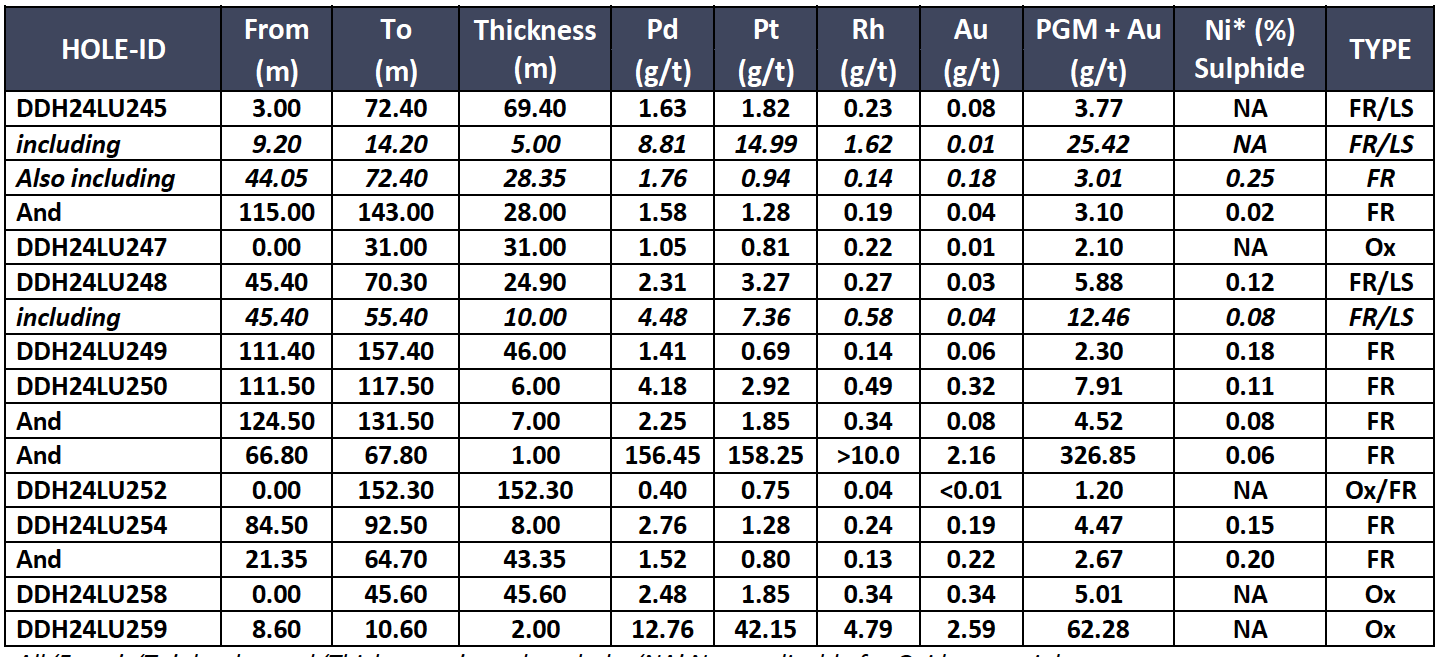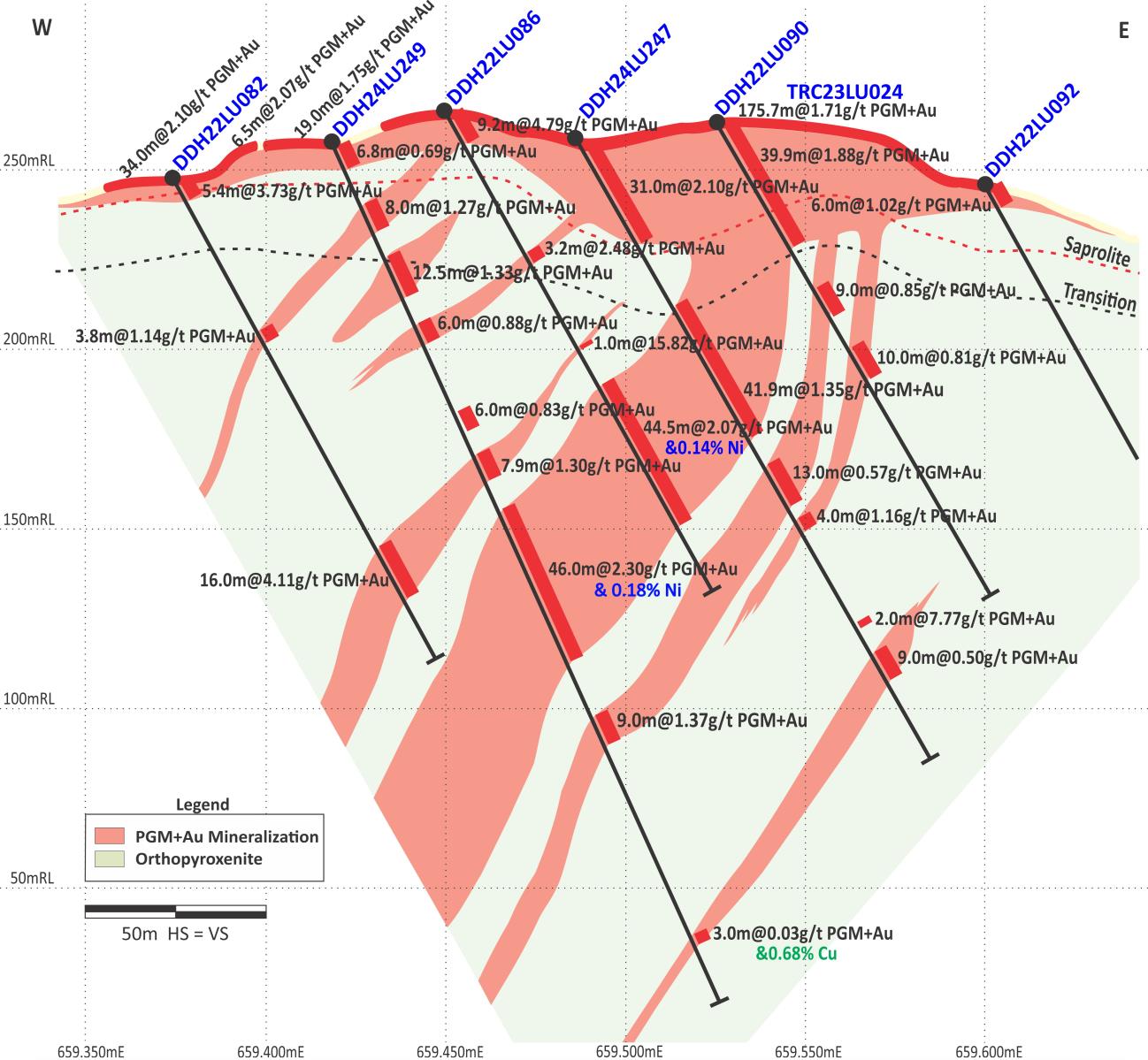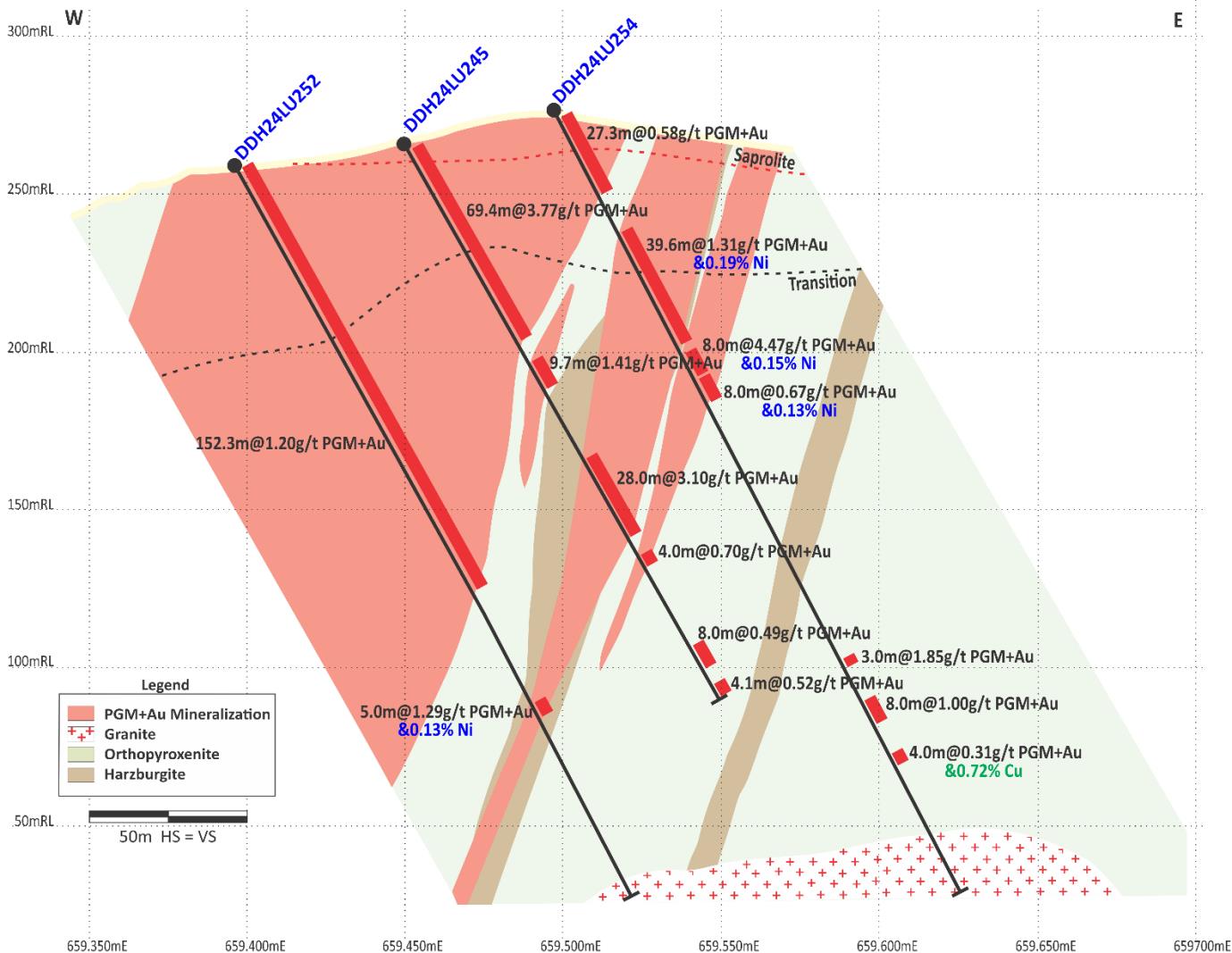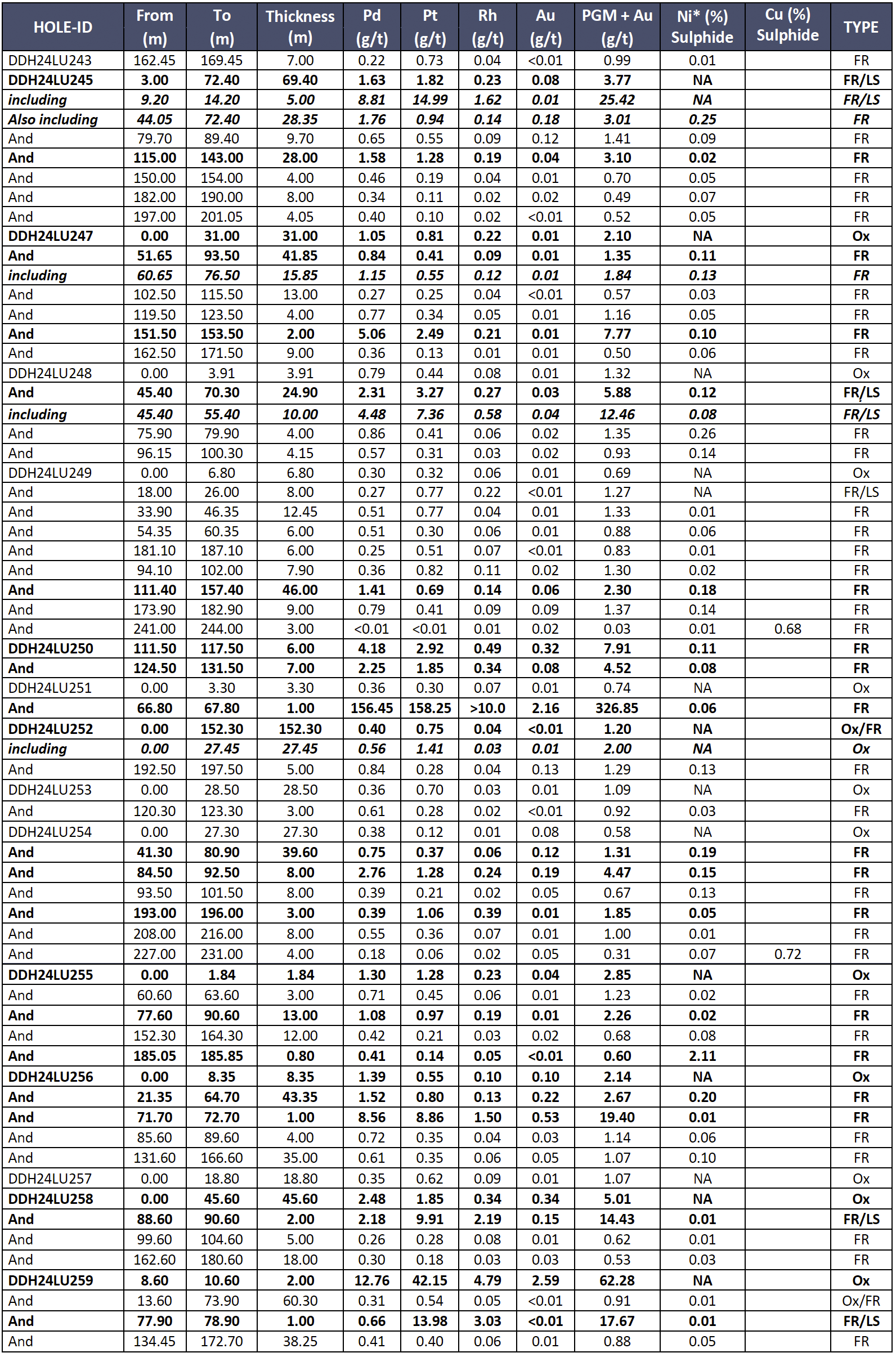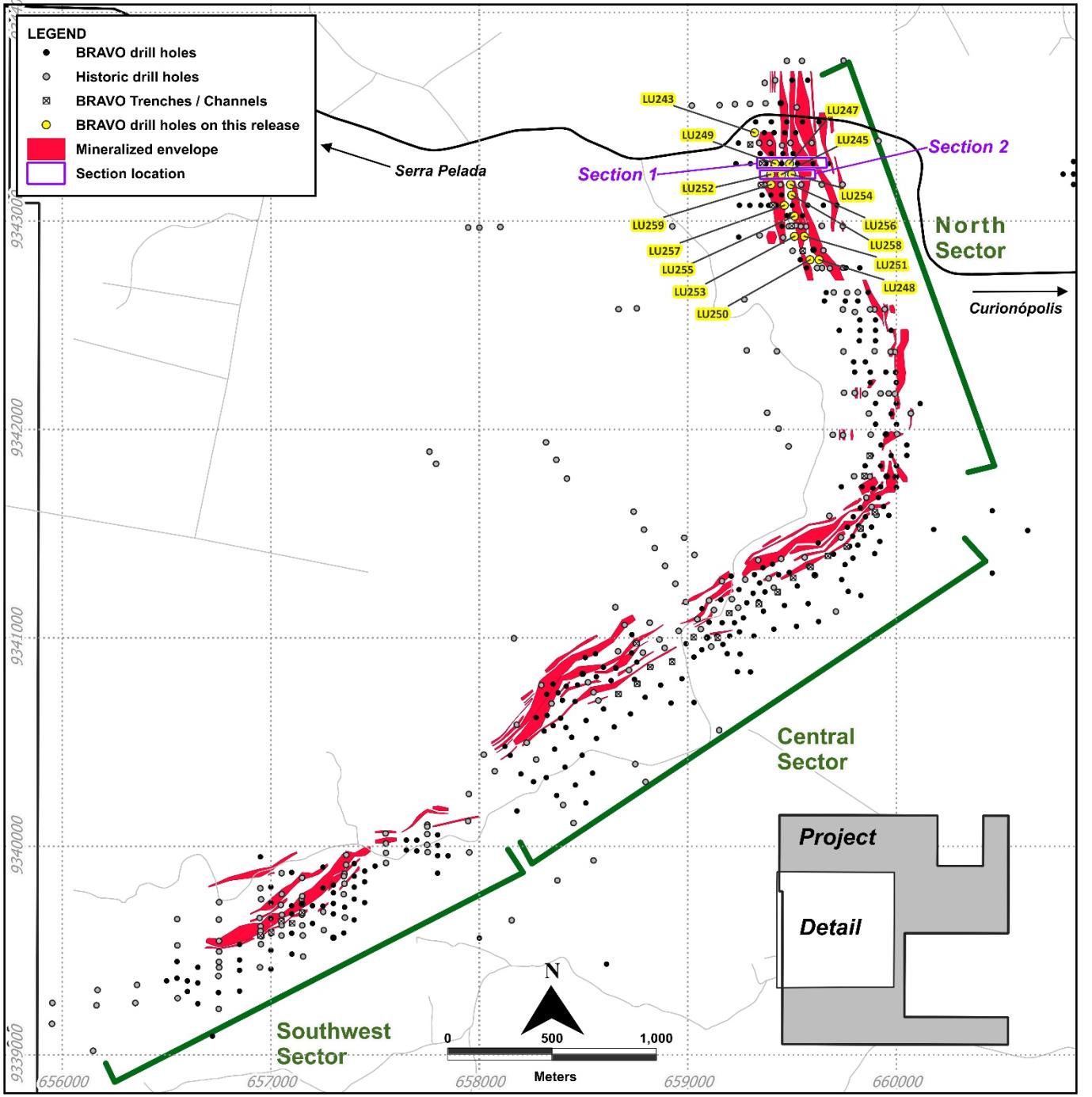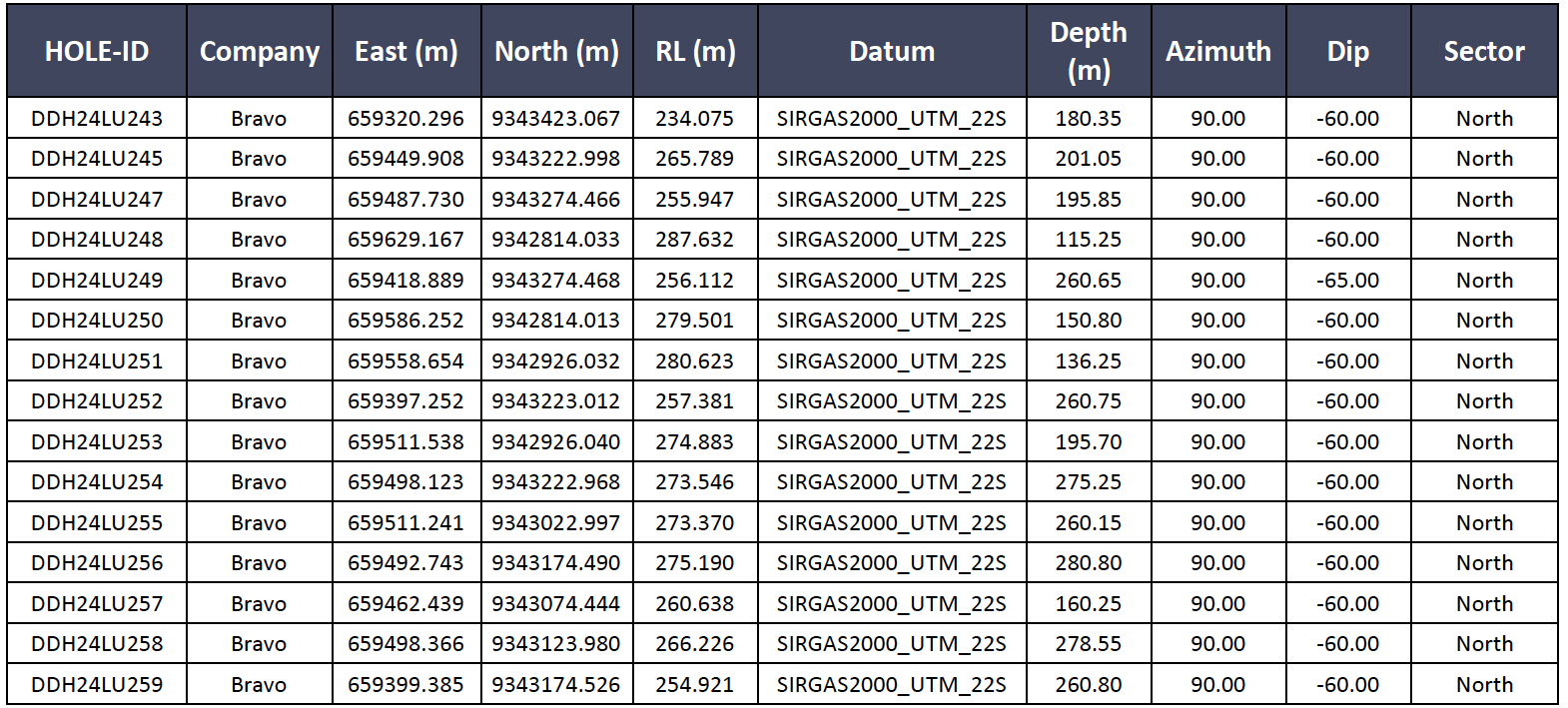Highlights include 69m at 3.8g/t PGM+Au including 5m at 25.4g/t PGM+Au,
45m at 5.0g/t PGM+Au, and 24.9m at 5.9g/t PGM+Au, 0.12% Ni
VANCOUVER, July 29, 2024 – Bravo Mining Corp. (TSX.V: BRVO, OTCQX: BRVMF), (“Bravo” or the “Company”) has received assay results from fifteen diamond drill holes (“DDH”) from the North Sector at its 100% owned Luanga palladium + platinum + rhodium + gold + nickel deposit (“Luanga deposit” or “Luanga PGM+Au+Ni deposit”), located in the Carajás Mineral Province, state of Pará, Brazil.
“The numerous thick high-grade drill intercepts from the North Sector of the Luanga deposit has significantly enhanced the resource potential in this area, thus establishing a second centre of gravity for the Luanga deposit,” said Luis Azevedo, Chairman and CEO. “In the Luanga deposit mineral resource estimate (“MRE”. See press release October 22, 2023), the Central Sector was seen to host a large proportion of the mineral resources, largely due to the concentration of historical holes and Bravo drilling. In contrast, the North Sector had only seen limited drilling at the time of the MRE. However, Bravo’s recent drilling, has consistently intercepted thicker zones of higher-grade mineralization within 150m of surface, as illustrated by the sections in this press release.”
Highlights Include:
- Drilling in the North Sector continues to show improvements in both grade and thickness compared to historic drilling in this sector.
- Mineralization intersected to date (see Sections 1 and 2) lies within 150m of surface and is open to further extension at depth.
- The North Sector at the Luanga deposit is now recognised as a second centre of gravity of multiple thick high grade mineralized zones.
- The current round of BHEM (bore-hole electromagnetic) surveying is close to completion. Drilling has recommencing at T5, testing new conductors along strike defined by this work. This will be followed by drilling at new and re-evaluated HeliTEM targets.
|
Notes: |
All ‘From’, ‘To’ depths, and ‘Thicknesses’ are downhole. ‘NA’ Not applicable for Oxide material. |
Luanga Drilling Update
Results from fifteen diamond drill holes have been received from the North Sector of the Luanga PGM+Au+Ni deposit. All the drill holes reported herein are angled holes (-60 degrees), towards an azimuth of 090°. Together, this set of drill holes comprise a total of 3,212.45 metres of diamond drilling.
Section 1 (Figure 1) in the North Sector shows infill and step-out drilling, with DDH24LU249 being the deepest drill hole on the section, exhibiting a wide zone of mineralization, open at depth, within 150m from surface, and consistently increasing in grade from DDH22LU090 to DDH24LU247 to DDH22LU086 to DDH24LU249. Trenching (TR23LU024) in this area also demonstrates the significant volume of near surface oxide mineralization. These results continue to bode well for potential future MRE updates. In comparison, the Central Sector has been defined to depths of up to 400m below surface, more than twice the depth of current drilling in the North Sector. The addition of a second centre of gravity for the Luanga PGM+Au+Ni deposit has potential to enhance future project economics, as and when demonstrated, mineralization could potentially be extracted from shallower depths for longer periods.
Figure 1: North Sector (Section 1 on Figure 3). High-grade and thick mineralization near surface and continuing at depth.
Section 2 (Figure 2) is an infill section in the North Sector. Drilling also shows evidence of increasing thickness at depth, again with mineralization defined to date less than 150m from surface and still open at depth. As with Section 1 and in comparison, to the Central Sector, there is still significant potential to extend mineralization to depth while remaining potentially amenable to open pit exploitation, subject to future economic studies. Furthermore, Section 2 shows high volumes of mineralization in comparison to the volume of unmineralized material, demonstrating the potential for relatively low strip ratios in these areas.
Figure 2: North Sector (Section 2 on Figure 3). Wide zones of mineralization with low proportions of unmineralized material.
HeliTEM (Helicopter borne EM) and Copper/Gold Exploration Update
Exploration is progressing on both BHEM targets and HeliTEM targets. The current round of BHEM surveying is close to completion. Drilling has recommencing at T5, testing new conductors defined along strike by this work. BHEM is currently in progress at T11. Following the new holes planned at T5, drilling will move to T11, followed by initial testing of new and re-evaluated HeliTEM targets.
Drill Results Status Update
A total of 311 drill holes have been completed by Bravo to date, for 66,366 metres, including 8 metallurgical holes (not subject to routine assaying). Results have been reported for 267 Bravo drill holes to date. Assay results for 36 Bravo drill holes that have been completed are currently outstanding (excluding the metallurgical holes).
Complete Table of Recent Intercepts.
|
Notes: |
All ‘From’, ‘To’ depths, and ‘Thicknesses’ are downhole. ‘NA’ Not applicable for Oxide material. |
Figure 3: Location of Bravo Drilling and Sections Reported in this News Release
About Bravo Mining Corp.
Bravo is a Canadian and Brazil-based mineral exploration and development company focused on advancing its Luanga PGM+Au+Ni Project in the world-class Carajás Mineral Province of Brazil.
The Luanga Project is situated on mature freehold farming land and benefits from being in a location close to operating mines and a mining-experienced workforce, with excellent access and proximity to existing infrastructure, including road, rail, and clean renewable hydro grid power. A fully funded 63,000m infill, step out and exploration drilling and trenching program is well advanced for 2024. Bravo’s current Environmental, Social and Governance activities includes planting more than 30,000 high-value trees in the project area, hiring and contracting locally, and ensuring protection of the environment during its exploration activities.
Technical Disclosure
Technical information in this news release has been reviewed and approved by Simon Mottram, F.AusIMM (Fellow Australia Institute of Mining and Metallurgy), President of Bravo Mining Corp. who serves as the Company’s “qualified person” as defined in National Instrument 43-101 Standards of Disclosure for Mineral Projects (“NI 43-101”). Mr. Mottram has verified the technical data and opinions contained in this news release.
For further information about Bravo, please visit www.bravomining.com or contact:
Alex Penha
EVP Corporate Development
info@bravomining.com
Forward Looking Statements
This news release contains forward-looking information which is not comprised of historical facts. Forward-looking information is characterized by words such as “thick”, “high-grade”, “centre of gravity”, “numerous”, “significantly”, “enhanced”, “potential”, “concentration”, “consistently”, “improvement”, “extension”, “centre of gravity”, “numerous”, “bodes well”, variants of these words and other similar words, phrases, or statements that certain events or conditions “may” or “will” occur. This news release contains forward-looking information pertaining to the Company’s ongoing drill program and the results thereof; comparisons to historical and/or prior Bravo drilling; the potential for extensions to mineralization at depth; the potential for greater thicknesses and/or higher grades at depth; the impact of current and future drilling on future mineral resource estimates, after taking into account other modifying factors; whether or not the mineralization is amenable to open pit mining and, if so, to what extent; the potential for a second centre of gravity for the Luanga deposit; potential economic outcomes, including strip ratios, in future economic studies; and the Company’s plans in respect thereof. Forward-looking information involves risks, uncertainties and other factors that could cause actual events, results, and opportunities to differ materially from those expressed or implied by such forward-looking information. Factors that could cause actual results to differ materially from such forward-looking information include, but are not limited to, unexpected results from exploration programs, changes in the state of equity and debt markets, fluctuations in commodity prices, delays in obtaining required regulatory or governmental approvals, environmental risks, limitations on insurance coverage; and other risks and uncertainties involved in the mineral exploration and development industry. Forward-looking information in this news release is based on the opinions and assumptions of management considered reasonable as of the date hereof, including, but not limited to, the assumption that the assay results confirm that the interpreted mineralization contains significant values of nickel, PGMs and Au; that the mineralization remains open to depth, that PGM and/or Ni grades and mineralized thicknesses are improving to depth; that final drill and assay results will be in line with management’s expectations; that activities will not be adversely disrupted or impeded by regulatory, political, community, economic, environmental and/or healthy and safety risks; that the Luanga Project will not be materially affected by potential supply chain disruptions; and general business and economic conditions will not change in a materially adverse manner. Although the Company believes that the assumptions and factors used in preparing the forward-looking information in this news release are reasonable, undue reliance should not be placed on such information. The Company disclaims any intention or obligation to update or revise any forward-looking information, other than as required by applicable securities laws.
Schedule 1: Drill Hole Collar Details
Schedule 2: Assay Methodologies and QAQC
Samples follow a chain of custody between collection, processing, and delivery to the SGS Geosol laboratory in Parauapebas, state of Pará, Brazil. The drill core is delivered to the core shack at Bravo’s Luanga site facilities and processed by geologists who insert certified reference materials, blanks, and duplicates into the sampling sequence. Drill core is half cut and placed in secured polyurethane bags, then in security-sealed sacks before being delivered directly from the Luanga site facilities to the Parauapebas SGS Geosol laboratory by Bravo staff. Additional information about the methodology can be found on the SGS Geosol website (SGS) in their analytical guides. Information regarding preparation and analysis of historic drill core is also presented in the table below, where the information is known.
Quality Assurance and Quality Control (“QAQC”) is maintained internally at the lab through rigorous use of internal certified reference materials, blanks, and duplicates. An additional QAQC program is administered by Bravo using certified reference materials, duplicate samples and blank samples that are blindly inserted into the sample batch. If a QAQC sample returns an unacceptable value an investigation into the results is triggered and when deemed necessary, the samples that were tested in the batch with the failed QAQC sample are re-tested.

